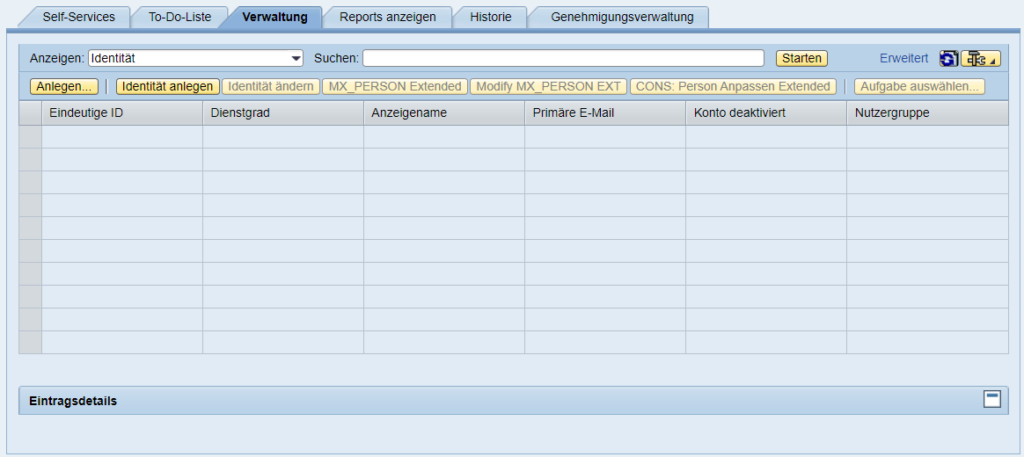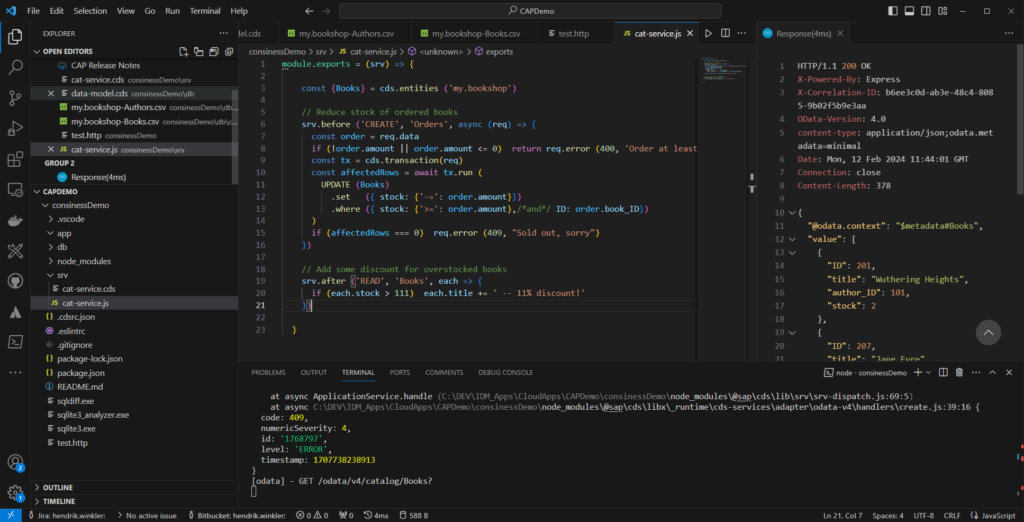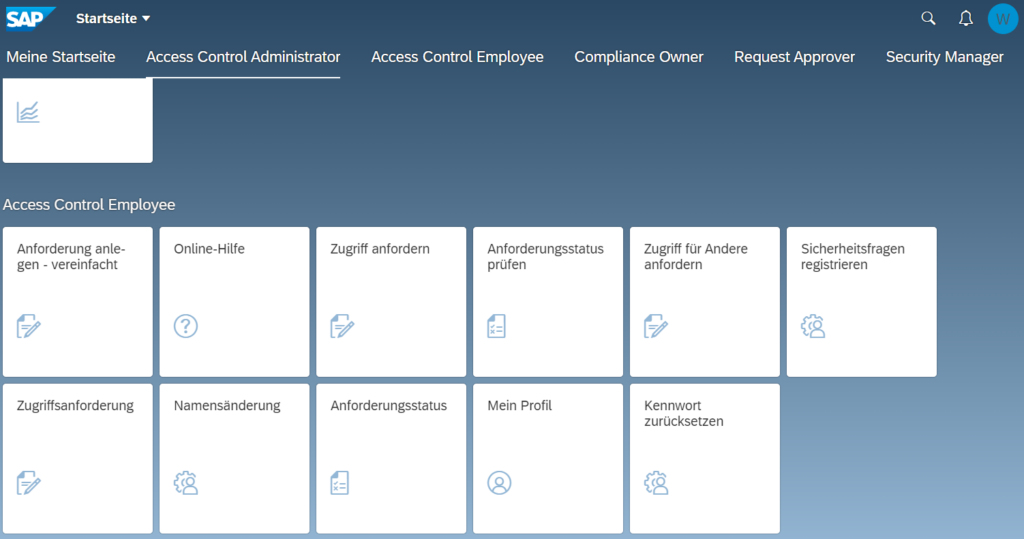n this article series we want to provide an overview of possible options for companies and give a brief assessment of the strengths and weaknesses of each solution. Please note that these assessments should in no way be considered final and do not replace individual consulting.
- Part 1: The End of an Era – The Future After SAP IDM
- Part 2: SAP – Cloud Identity Services, GRC edition for SAP HANA
- Part 3: Cloud Services – Microsoft Entra, Okta, Omada Identity
- Part 4: On-Premise Solutions – e.g. One Identity, SIVIS
This part takes a deeper look at the various SAP solutions that are central for companies of all sizes and industries. As an introduction, we discuss continuing operation of SAP Identity Management (IDM), which will likely remain a transitional solution for many SAP customers. Key components of the future include SAP Cloud Identity Services in combination with SAP Identity and Access Governance (IAG). Moreover, we shed light on the importance of SAP CAP (Cloud Application Programming) applications, which may help close functional gaps in the cloud infrastructure. Finally, SAP GRC (Governance, Risk, and Compliance) is discussed, which plays a decisive role in ensuring corporate compliance and risk management, yet is often also used in the implementation of identity management.
Option A: Continuing Operation of SAP IDM 8.0
Option B: Running SAP IDM 8.0 in the Cloud?
Option C: SAP Cloud Identity Services – IAS/IPS + IAG
Option D: SAP Cloud Identity Services and CAP Extensions
Option E: SAP GRC 12.0 / edition for SAP HANA
Option A: Continuing Operation of SAP IDM 8.0
The last service pack for SAP IDM 8.0 was released more than three years ago. A pointed question arises: what support does SAP really intend to provide? Over time, many customers have built practical solutions or workarounds and may operate without further patches.

However, the decision is not that simple. The problem lies especially in the IT security of the underlying AS Java components, for which constant security updates are offered. Those who do not keep these components “up to date” risk the long-term integrity of their system landscape.
Thus, continuing with IDM 8.0 is more of a “wait-and-see” strategy before the inevitable transition takes place. It’s also not impossible that an extended support option for some (large) customers, or even general extension, may be offered. Whether only support is discontinued or whether an effective prohibition of use for the AS Java environment will be imposed is unclear.
Advantages
- No additional initial effort
- Wait for market consolidation or new developments from SAP to make a better decision later
Disadvantages
- Ongoing investment in a dying software
- Declining availability of specialists
- From about 2030 onwards, security restrictions likely
- Possibly usage restrictions or prohibition after 2030
Assessment
From our point of view, waiting and continuing operation of SAP IDM 8.0 is a valid strategy—especially for very small or agile implementations that can be replaced in time. Complex landscapes, however, must be migrated over several years. For companies planning a cloud transformation, it may make more sense to invest directly in a new solution. However, we cannot recommend long-term planning based on SAP IDM 8.0.
Option B: Running SAP IDM 8.0 in the Cloud?
A post in DSAG forums by the company ROIABLE announced a BTP port for SAP IDM 8.0. The idea is: since fundamentally only the support for AS Java is to be discontinued, one could migrate the IDM components to SAP BTP and offer them there as a service.
While this sounds promising—especially since ROIABLE is known in the SAP IDM scene—a practical implementation is likely to receive little acceptance from SAP, making it a risky move.
Advantages
- Minimal porting effort
- Eliminate the problematic AS Java component
- Potential performance benefits
- Closer integration in cloud networks
Disadvantages
- Not supported by SAP
- No planning reliability
Assessment
The idea is attractive enough to mention, but due to external constraints should not be seriously declared as a strategy.
Option C: SAP Cloud Identity Services – IAS/IPS + IAG
Welcome to the jungle of SAP cloud services. The two BTP services for Identity Authentication (IAS) and Identity Provisioning (IPS) are grouped under the name SAP Cloud Identity Services.

IAS and IPS are available as part of the SAP Cloud Identity Services and play an important role within the SAP Business Technology Platform (SAP BTP) ecosystem—particularly when it comes to the integration and management of identities and access rights.
For SAP BTP customers, IAS and IPS are fundamental services, especially relevant when using other SAP cloud solutions such as SAP SuccessFactors or SAP S/4HANA Cloud. SAP BTP is designed to deliver its cloud solutions with integrated identity authentication, meaning that IAS/IPS are required to ensure seamless and secure access to these applications.
In terms of cost, IAS and IPS are included by default within the SAP BTP framework and do not require additional licensing when used in connection with an SAP cloud solution, an SAP on-premise application, or an SAP system hosted on SAP HANA Enterprise Cloud. Customers typically receive one productive and one test tenant without additional license fees. However, if additional tenants are required, these must be purchased separately.
For customers under the Cloud Platform Enterprise Agreement (CPEA) contract, the pricing model is consumption-based, meaning that you only pay for the services actually used. There is also the option to purchase additional cloud credits to increase your initial commitment and thus avoid overconsumption. Customers can manage their service usage via the SAP BTP cockpit and receive monthly invoices to maintain transparency regarding incurred costs.
SAP Cloud IAG (Identity Access Governance) is the “cloud successor to GRC” and, in our assessment, still in its early development stages. Why the quotation marks? As expected, SAP would, according to its overall strategy, like to completely replace GRC with Cloud IAG. However, this contradicts SAP’s announcement of SAP GRC edition for HANA, scheduled for 2026 (more on that in the section about SAP GRC).

SAP IAG offers functions that will strongly remind you of GRC: access analysis, business role management, access reviews, and workflows that enable companies to effectively enforce their access policies while maintaining compliance requirements.
Advantages
- Rapid deployment and potentially lower total cost of ownership (to be calculated on a case-by-case basis)
- IAS/IPS are a given for hybrid SAP landscapes
- Central identity provider for both cloud and on-premise applications
- Supports standardized authentication methods, including existing identity providers (e.g. login via Apple ID)
- IAS enables single sign-on functionality
- Dynamic adjustment of account and user authorizations
Disadvantages
- May be less suitable for highly specific, non-standard IAM processes
- Limited customization and development capabilities
- May require process standardization
- More restricted monitoring capabilities compared to SAP IDM
- Troubleshooting cloud interactions can be more complex
- BTP and Cloud Identity Services evolve at a relatively rapid pace – which isn’t always beneficial if a minimal and stable solution is desired
Assessment
SAP Cloud Identity Services are a given when operating within SAP BTP.
However, in our assessment, these solutions cannot be regarded or used as complete IAM products.
SAP itself seems to share this view—positioning Cloud Identity Services largely as middleware solutions alongside Microsoft Entra.
The use of Cloud Identity Services as a replacement for SAP IDM can therefore only be recommended in specific cases:
- Companies with a cloud focus or hybrid landscapes: Since IAS and IPS are specifically designed for cloud environments, they are well suited for organizations that already have—or plan to build—a strong cloud presence.
- Companies with simple, standardized IAM processes: It should be evaluated case by case whether IAM processes can be simplified enough for IAS/IPS and IAG to suffice.
- Companies requiring fast and scalable solutions: As both services are cloud-based, they offer rapid deployment and scalability, which can be particularly advantageous for growing businesses.
For the following types of organizations, IAS/IPS may be less suitable:
- Companies that do not (yet) want or are unable to use the cloud
- Companies with highly specific, non-standard IAM requirements:
If an organization has very specialized authentication and identity management needs that go beyond the standard features of IAS and IPS, a custom-built solution may be necessary.
Ultimately, the decision for or against IAS/IPS depends on the specific requirements and goals of each organization.
Option D: SAP Cloud Identity Services and CAP Extensions
The weaknesses of SAP IAS and IPS—such as their limited flexibility for individual customization and restricted monitoring capabilities—can be mitigated by developing custom CAP (Cloud Application Programming Model)applications.
CAP provides a comprehensive programming environment that allows the creation of tailored extensions and adaptations specifically aligned with a company’s individual needs.

For example, custom CAP-based applications can be developed to integrate advanced functionalities into your BTPenvironment that go beyond the standard capabilities of IAS/IPS and even IAG—such as complex approval workflowsor customized user management processes.
In addition, CAP offers a flexible platform to optimize the integration of IAS/IPS with other systems and services. This can be particularly useful for enabling seamless connectivity between cloud and on-premise systems in hybrid IT landscapes. By leveraging CAP, companies can therefore compensate for the limitations of IAS/IPS and create a more comprehensive identity and access management system tailored to their specific requirements.
Advantages
- Enables third parties to implement services that are tailored to specific customer needs
- Greatly simplified entry point for newcomers to SAP development through CAP
- Allows the use of SAP Cloud Platform Workflow
- Facilitates the development of migration paths from SAP IDM → SAP Cloud for a seamless transition and reuse of existing processes
Disadvantages
- Deviates from SAP’s standard solution
- Custom developments must mature over time before full adoption
Assessment
The extendability of the standard has always been one of the main arguments in favor of using SAP.
Through the standardization of Cloud Identity Services, many customers could face hurdles that might otherwise lead them to adopt third-party solutions.
However, with CAP, SAP has created a platform that enables open development of additional modules by third parties, which can be natively integrated into the SAP BTP ecosystem.
The first developers are already working on implementing IAM modules that extend or even partially replace IAS/IPS.
For companies planning an IT architecture with SAP Cloud as the central element, this approach is likely the most elegant.
However, it remains to be seen what capabilities and limitations will emerge from the development of CAP applications for IAM.
As soon as there are updates on this option, we will report on them promptly.
Option E: SAP GRC 12.0 / edition for SAP HANA
The tremendous success of GRC AC 12.0 and its predecessors could not be ignored by SAP, and with the official announcement of SAP GRC edition for SAP HANA, the strategic direction is clear: SAP GRC lives on!

GRC is a compliance tool, but it encompasses far more than the modules commonly known in IAM circles, creating positive synergies for the further development of the GRC platform.
The modules relevant to IAM are grouped under the product GRC Access Control:
- ARA – Access Risk Analysis
- EAM – Emergency Access Management
- BRM – Business Role Management
- ARM – Access Request Management
- UAR – User Access Review
The biggest arguments against GRC have been (and still are) that, first, the solution was not originally designed or built as an identity lifecycle management system, and second, it lacked integration with non-SAP products.
To close these gaps, SAP’s prescribed architecture was to use both SAP IDM and GRC together. These were connected through one of the many (albeit cumbersome in practice) integration scenarios between IDM and GRC.
Nevertheless, the sum of the available components, combined with the proven ABAP stack, led many companies to adopt GRC Access Control as an “IDM-light” solution.
Any functional gaps were often closed through custom extensions developed over the years, thanks to GRC’s excellent extensibility.
These companies may now find themselves the fortunate winners, benefiting from a modern, future-proof technology stack, enhanced Fiori interfaces, and improved reporting capabilities.
Advantages
- Proven technology stack based on ABAP/HANA DB
- Established and mature solution for the lifecycle of permissions and business roles (Access Governance)
- Flexible workflow design using MSMP (Multi Step Multi Process)
- Good availability of GRC experts, as well as ABAP and Fiori developers
- Future-proof
- Easy integration with ABAP-based landscapes
Disadvantages
- Strategically designed primarily as a compliance tool, not as a full IAM solution
- Integration with non-SAP systems may require development of custom connectors
- Customization is more complex and time-consuming compared to SAP IDM
- Highly complex solution (challenging for new customers or those seeking lean implementations)
- In-house competition from SAP Cloud IAG
Assessment
Even if SAP might not officially acknowledge this view, GRC is definitely a serious option for companies currently using the SAP + IDM tandem.
It’s no coincidence that, over the past few years, a “GRC fan community” has emerged within the SAP ecosystem—far larger than IDM could ever achieve.
Each company should carefully consider how to transfer missing IDM functionalities into GRC, particularly in SAP-centric infrastructures that value complex special cases and risk analysis capabilities.
If SAP software is already established and cloud integration is (for now) not a priority, choosing GRC is almost an automatic decision.
However, it’s important to keep in mind that SAP GRC is complex, costly, and resource-intensive—a factor that must not be underestimated.
Summary
We hope this overview helps you plan your future IAM architecture.
Even within the SAP ecosystem, there are numerous options for managing identities and access rights, depending on the infrastructure in place.
As mentioned in the introductory article, the fundamental question of cloud orientation is indispensable for making the right decision.
In this context, we also recommend reading Part 3 of this article series, which discusses Microsoft Entra, the officially announced successor solution by SAP.wird.
Next Part 3: Cloud Services – Microsoft Entra, Okta, Omada Identity
about the author

Hendrik Winkler is a partner at consiness and the lead architect for Identity and Access Management solutions. He draws on extensive expertise in SAP ABAP, GRC, cloud technologies, and SAP Identity Management. With more than ten years of experience in the IT industry, he has specialized in the development and implementation of complex IAM systems, always keeping a close eye on security, usability, and compliance.

